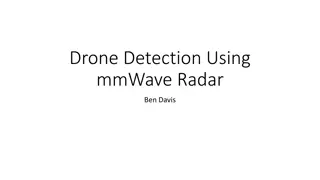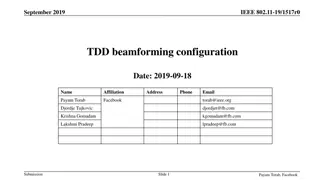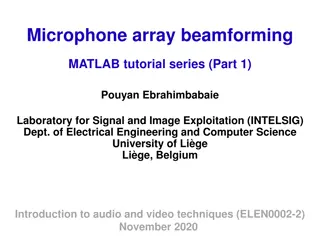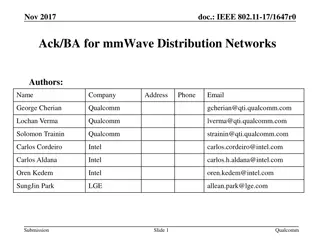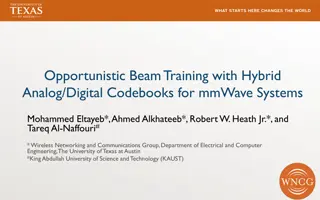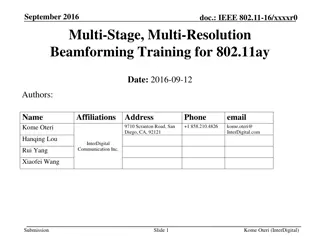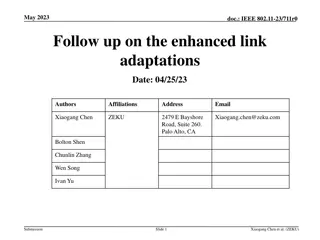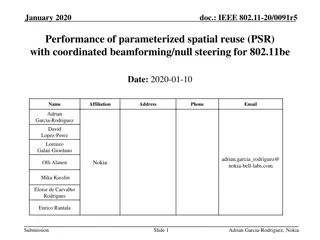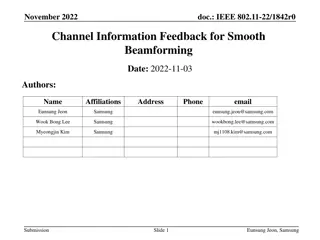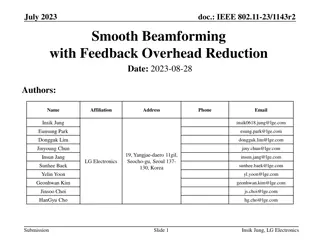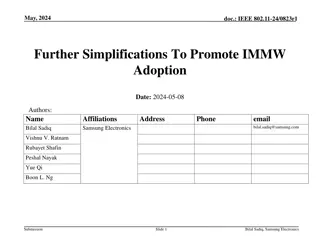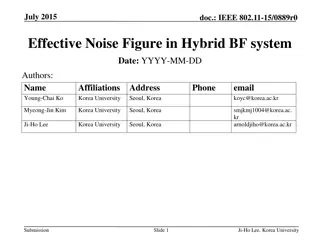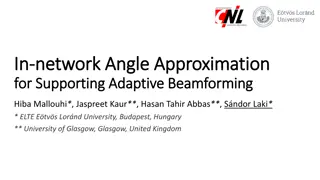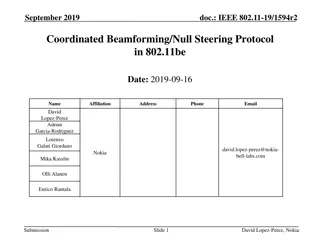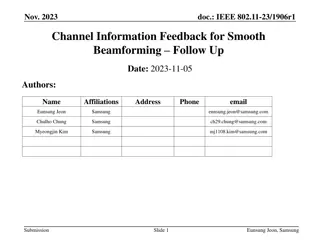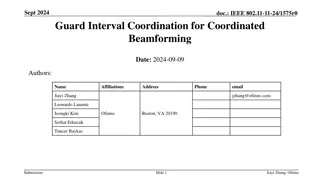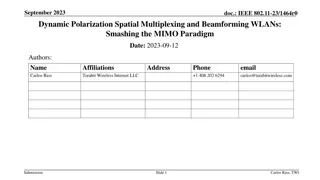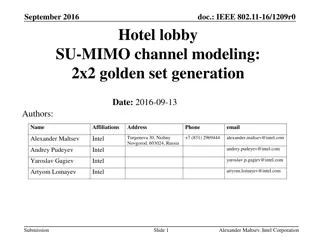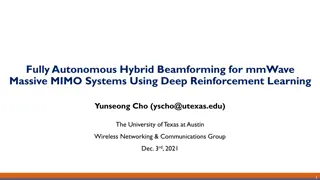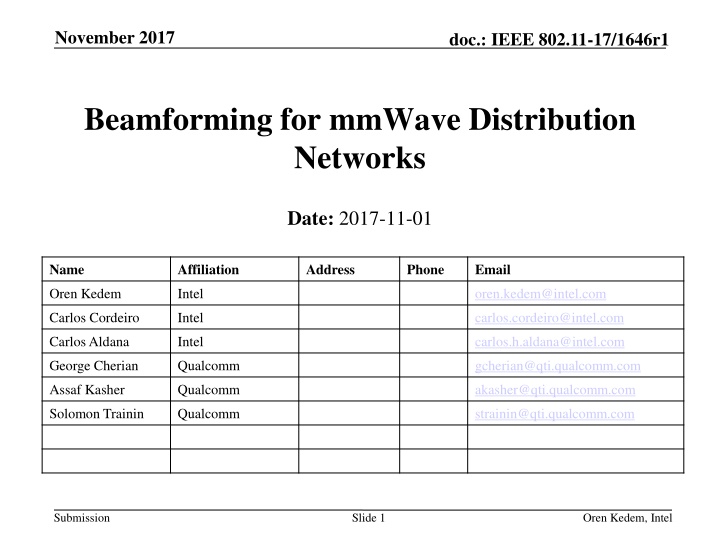
Beamforming Protocol Proposal for TDD Channel Access
Explore a beamforming protocol proposal for TDD channel access in mmWave distribution networks, addressing the limitations of existing paradigms. The presentation outlines asynchronous and synchronous beamforming approaches, frame formats, and key assumptions for effective implementation.
Download Presentation

Please find below an Image/Link to download the presentation.
The content on the website is provided AS IS for your information and personal use only. It may not be sold, licensed, or shared on other websites without obtaining consent from the author. If you encounter any issues during the download, it is possible that the publisher has removed the file from their server.
You are allowed to download the files provided on this website for personal or commercial use, subject to the condition that they are used lawfully. All files are the property of their respective owners.
The content on the website is provided AS IS for your information and personal use only. It may not be sold, licensed, or shared on other websites without obtaining consent from the author.
E N D
Presentation Transcript
November 2017 doc.: IEEE 802.11-17/1646r1 Beamforming for mmWave Distribution Networks Date: 2017-11-01 Name Affiliation Address Phone Email Oren Kedem Intel oren.kedem@intel.com Carlos Cordeiro Intel carlos.cordeiro@intel.com Carlos Aldana Intel carlos.h.aldana@intel.com George Cherian Qualcomm gcherian@qti.qualcomm.com Assaf Kasher Qualcomm akasher@qti.qualcomm.com Solomon Trainin Qualcomm strainin@qti.qualcomm.com Submission Slide 1 Oren Kedem, Intel
November 2017 doc.: IEEE 802.11-17/1646r1 Introduction and problem statement The beamforming paradigm defined in 11ad/11ay assume that: Transmitted BF frames are always separated by a known interframe space (SBIFS, MBIFS, LBIFS) Initiator and responder training take place back to back (e.g., ISS- >RSS->Feedback->Ack) This paradigm is not suitable to networks employing the TDD channel access [1][2], given the strict delineation between TX and RX TDD-Slots Therefore, in this presentation we propose a BF protocol suited to TDD channel access Submission Slide 2 Oren Kedem, Intel
November 2017 doc.: IEEE 802.11-17/1646r1 Outline Review of beamforming approach described in [2] Asynchronous BF Synchronous BF TDD beamforming proposal BF protocol Frame formats Submission Slide 3 Oren Kedem, Intel
November 2017 doc.: IEEE 802.11-17/1646r1 Asynchronous BF: assumptions Asynchronous beamforming is the case when the frame and slot boundary timing is unknown to the Responder Responder starts in continuous sweep, switches to slotted sweep after being hit with a beam The asynchronous BF procedure assumes reciprocity Responder knows (provided through SME with) Number of Tx beams used by initiator Continuous sweep period Submission Slide 4 Oren Kedem, Intel
November 2017 doc.: IEEE 802.11-17/1646r1 Asynchronous BF Time to send TrnRsp and TrnRspAck is strictly defined TXBeamIndex = 1 FrameNumInBF = 30 TXBeamIndex = 1 FrameNumInBF = 31 TXBeamIndex = 1 FrameNumInBF = 31 TXBeamIndex = 2 FrameNumInBF = 22 TrnRspAck TrnReq TrnReq TrnReq TrnReq TrnReq TrnReq Initiator (DN) RX Slot TrnRsp Responder (DN/CN) TX Slot TXBeamIndex = 3 RXBeamIndex = 30 RxBeamLQM = High SNR TrnReq packets continue to be transmitted until initiator decides to stop the training (i.e., multiple TrnRsp and TrnRspAck frames can be exchanged during beamforming.) The size of two TrnReq messages is assumed to be the size of a slot (cannot be assumed by 11ay) TrnReq are transmitted in every first slot of a frame; this assumption helps the CN to calculate the time to send the TrnRsp The partition between TX/RX slots is assumed to be equal Submission Slide 5 Oren Kedem, Intel
November 2017 doc.: IEEE 802.11-17/1646r1 Synchronous BF Synchronous beamforming is the case when the frame and slot boundary timing is known to the Responder Responder starts in slotted sweep, using a schedule Initiator behavior does not change compared to asynchronous BF SME indicates to responder when to start synchronous BF, so that the responder can start scanning Rest of the procedure is nearly the same Submission Slide 6 Oren Kedem, Intel
November 2017 doc.: IEEE 802.11-17/1646r1 BF: implications to 11ay In 11ay, the slot structure may vary between implementations Hence, the 11ay asynchronous BF procedure can only assume: Reciprocity (antenna pattern) Number of RX sectors of responder The 11ay asynchronous BF procedure cannot assume Frame size (TDD Slot) Split of frame TX and RX Submission Slide 7 Oren Kedem, Intel
November 2017 doc.: IEEE 802.11-17/1646r1 Outline Review of beamforming approach described in [2] Asynchronous BF Synchronous BF TDD beamforming proposal BF protocol Frame formats Submission Slide 8 Oren Kedem, Intel
November 2017 doc.: IEEE 802.11-17/1646r1 TDD beamforming: considerations & definitions The cornerstone of all existing 11ad/11ay BF protocols are the SSW and BRP frames, which are used in the SLS and BRP beamforming phases Attempting to reuse these frames or protocols to define the TDD beamforming protocol is impractical: Will lead to incorrect legacy (11ad) device behavior, since legacy devices will assume the traditional 11ad BF protocol Behavioral exceptions will have to be created in numerous places Complex to merge two disparate procedures Propose to define a separate BF frame and protocol: Define new TDD Beamforming frame of subtype Control Frame Extension Define new TDD beamforming procedure Submission Slide 9 Oren Kedem, Intel
November 2017 doc.: IEEE 802.11-17/1646r1 New Control Frame Extension TDD Beamforming Type value B3 B2 Control Frame Extension value B11 B10 B9 B8 Subtype value B7 B6 B5 B4 Subtype description 01 0110 (Control) 1001 SSW-Feedback 01 0110 (Control) 1010 SSW-Ack 01 0110 (Control) 1011 TDD Beamforming 01 0110 (Control) 1100-1111 Reserved Submission Slide 10 Oren Kedem, Intel
November 2017 doc.: IEEE 802.11-17/1646r1 TDD Beamforming frame format TDD Beamforming frame format TDD Beamforming frame defined as Control Frame Extension subtype TDD BF frame includes the following fields: Duration - Set to the time until the end of the TDD slot where the TDD Beamforming frame is transmitted. RA - Contains the MAC address of the STA that is the intended receiver of the frame. TA - field contains the MAC address of the transmitter STA of the frame. TDD BF Control field TDD BF Frame Subtype - Indicates the frame subtype End of Training Indicates the end of BF training Frame Control Duration RA TA TDD BF Control Frame Body 6 FCS Octets : 2 2 6 6 1 4 TDD BF Control field format TDD BF Frame Subtype 2 End of Training Reserved Bits: 1 5 TDD BF Frame Subtype subfield 0 TDD SSW 1 TDD SSW Feedback 2 TDD SSW Ack 3 - Reserved Submission Slide 11 Oren Kedem, Intel
November 2017 doc.: IEEE 802.11-17/1646r1 TDD SSW frame TDD Beamforming frame format Frame Control Duration RA TA TDD BF Control Frame Body 6 FCS Octets : 2 2 6 6 1 4 TDD SSW frame body content TDD BF Control field format B0 B9 B10 B11 TX Beam Index B12 B26 Responder Feedback Offset B27 B41 Initiator Ack Offset B42 B45 Periodicity B46 B47 Reserved CDOWN TDD BF Frame Subtype 2 End of Training Reserved Bits : 10 2 15 15 4 2 Bits: 1 5 Tx Beam Index - Indicates the beam index used by the initiator to transmit the frame. CDOWN - Indicates the number of TDD SSW frames remaining to be transmitted within a TDD slot, such that the last transmitted TDD SSW frame in the TDD slot has this field equal to zero. Responder Feedback Offset - Indicates the offset, in units of 1 s, beginning immediately after the end of the TDD SSW frame, when the TDD SSW Feedback frame is transmitted by the responder station. Initiator Ack Offset- Indicates the offset, in units of 1 s, beginning immediately after the time indicated by the Responder Feedback Offset field when the TDD SSW Ack frame is transmitted by the initiator. Periodicity Indicates the offset, in units of TBD us, to the start of the next TDD slot used for TDD SSW transmission by the initiator. Submission Slide 12 Oren Kedem, Intel
November 2017 doc.: IEEE 802.11-17/1646r1 TDD SSW Feedback frame TDD Beamforming frame format Frame Control Duration RA TA TDD BF Control Frame Body 6 FCS Octets : 2 2 6 6 1 4 TDD SSW Feedback frame body content B0 B9 B10 B19 TX Beam Index 10 10 TDD BF Control field format B20 B27 SNR Report B28 B47 Reserved TDD BF Frame Subtype = 1 (TDD SSW Feedback) RX Beam Index End of Training Reserved Bits : 8 20 Bits: 2 1 5 TX Beam Index - Indicates the beam index received from the initiator RX Beam Index - Indicates the RX beam index used by the responder while it decoded the respective TDD SSW transmitted by the initiator in the indicated TX Beam Index. SNR Report - Indicates the SNR achieved while decoding the respective TDD SSW transmitted in the indicated TX Beam Index. Submission Slide 13 Oren Kedem, Intel
November 2017 doc.: IEEE 802.11-17/1646r1 TDD SSW Ack frame TDD Beamforming frame format Frame Control Duration RA TA TDD BF Control Frame Body 6 FCS Octets : 2 2 6 6 1 4 TDD SSW Ack frame body content TDD BF Control field format B0 B9 TX Beam Index 10 B10 B17 SNR Report B18 B33 Initiator Management Offset 16 B34 B41 Responder Management Offset 8 B42 B45 B46 B47 Reserved TDD BF Frame Subtype = 2 (TDD SSW Ack) End of Training Periodicity Reserved Bits : 8 4 2 Bits: 2 1 5 TX Beam Index - Indicates the TX beam index received from the responder SNR Report - Indicates the SNR achieved while decoding the TDD SSW Feedback frame received in the indicated TX beam index. Initiator Management Offset- Indicates the offset, in units of 1 s, beginning immediately after the end of the TDD SSW Ack frame when the Management frame carrying the network configuration is to be transmitted by the initiator. Responder Management Offset - Indicates the offset, in units of 1 s, beginning immediately after the time indicated by the Initiator Management Offset field when the responder is expected to respond to the Management frame sent by the initiator. Periodicity Indicates the offset, in units of TBD us, to the start of the next TDD slot used for retransmission of the initiator Management frames. Submission Slide 14 Oren Kedem, Intel
November 2017 doc.: IEEE 802.11-17/1646r1 TDD beamforming: Asyn/Sync procedure (0) For asynchronous beamforming, responder changes sweeping pattern from continuous to slotted when hit with a beam. Asynchronous Beam Forming Synchronous Beam Forming TDD SSW TDD SSW TDD SSW TDD SSW TDD SSW TDD SSW TDD SSW TDD SSW TDD SSW Ack Initiator (DN) TDD Slot TDD Slot TDD SSW Feedback Responder (DN/CN) TDD Slot Initiator sends multiple TDD SSW frames indicating the Initiator TX Beam Index and the time to send TDD SSW Feedback response Responder sends a TDD SSW Feedback frame with information on the decoded initiator beams. In response, the initiator sends a TDD SSW Ack frame with indications on how the responder can obtain the network configuration parameters. During the procedure, the TDD SSW frame is sent periodically and will typically span all of the initiator s beam indexes. Submission Slide 15 Oren Kedem, Intel
November 2017 doc.: IEEE 802.11-17/1646r1 TDD beamforming: Async procedure (1) TDD BF Frame set to subtype TDD SSW may be sent in any TDD slot assigned to the initiator and includes the following indications: Tx Beam Index Initiator Beam Index CDOWN indicates the number of TDD SSW frames remaining to be transmitted within a TDD slot Responder Feedback Offset Indicates to the responder when to send its training feedback. This value is updated at every TDD SSW transmission. Initiator Ack Offset - Indicates to the responder when initiator will send its feedback in response to the responder s training feedback. Initiator Ack Offset = 80 Initiator Ack Offset = 80 Initiator Ack Offset = 80 80us Responder Feedback Offset = 230 230us Responder Feedback Offset = 1000 1000us Responder Feedback Offset = 190 190us Responder Feedback Offset = 980 980us Responder Feedback Offset = 35 TDD SSW 35us TDD SSW TDD SSW TDD SSW TDD SSW TDD SSW TDD SSW TDD SSW TDD SSW Ack Initiator (DN) TDD Slot TDD Slot TDD SSW Feedback Responder (DN/CN) TDD Slot Submission Slide 16 Oren Kedem, Intel
November 2017 doc.: IEEE 802.11-17/1646r1 TDD beamforming: Async procedure (2) Initiator sends multiple TDD BF frame with subtype set to TDD SSW. Upon reception of a TDD SSW frame, the responder sends a TDD BF frame with subtype set to TDD SSW Feedback and including the decoded TX beams from the initiator After receiving the TDD SSW Feedback frame, the initiator sends a TDD BF frame with subtype set to TDD SSW Ack at the time as indicated in the Initiator Ack Offset subfield in the TDD SSW frame. The frame includes the decoded TX Beam of the responder and the offset time to exchange concluding management frames. During the initiator s TDD SSW Ack transmission, the responder adjusts its beam to the preferred antenna configuration as indicated by the RX Decoded Beam field. If the expected TDD BF Frame was not received, the BF procedure is assumed to be unsuccessful and may be repeated Submission Slide 17 Oren Kedem, Intel
November 2017 doc.: IEEE 802.11-17/1646r1 TDD beamforming: Sync procedure Sync BF may be initiated after Async BF is concluded or anytime when the STA is associated to network. Sync BF is similar to Async BF with the following modifications Initiator Starts with TXBeamIDx =0 after asynchronous BF has completed and ends with the maximum TXBeamIDx. (Antenna configuration may be communicated via TDD Beamforming frame (subtype TDD SSW Ack). Transmitted TDD BF frame in a TDD slot is done according to the periodicity as indicated in the TDD SSW frame. Responder Responder is timestamp synchronized and knows the network TDD slot structure. Responder switches it RX beams according to the periodicity indicted in the TDD SSW frame. Responder responds with a TDD BF frame set to TDD SSW Feedback subtype at the time indicated in the Response Feedback Offset value. Submission Slide 18 Oren Kedem, Intel
November 2017 doc.: IEEE 802.11-17/1646r1 TDD Route element format The TDD Route element is used to communicate the initiator TX beams as received by the STA during a TDD beamforming procedure Element ID Length Element ID Extension Number of TDD Routes 2 TDD Route 1 TDD Route N . Octets : 1 1 1 Variable Variable TX Beam Index Number of Decoded RX Beam 1 Decoded RX Beam Information 1 3 Decoded RX Beam Information M 3 . Octets : 2 B0 B9 RX Decoded Beam Index 10 B10 B17 B18 B23 Reserved RX Decoded Beam Link Quality 8 Bits : 6 TX Beam Index - Indicates the beam index received from the DN RX Decoded Beam Index - Indicates the RX beam index used by the responder while it decoded the respective TDD SSW transmitted in the respective TX Beam Index. RX Decoded Beam Link Quality - Indicates the SNR achieved while decoding the respective TDD SSW transmitted in the indicated TX Beam Index. The first RX Decoded Beam Link Quality indication field indicates the preferred beam to be used by the initiator and responder Submission Slide 19 Oren Kedem, Intel
November 2017 doc.: IEEE 802.11-17/1646r1 TDD BF procedure (example 1) TDD SSW Periodicity TDD SSW TDD SSW Feedback End of Training = 0 TDD SSW Ack TDD SSW TDD SSW End of Training = 1 TDD SSW End of Training = 1 TDD SSW Feedback End of Training = 1 TDD SSW Ack Management exchange timings (including retries) are in the TDD SSW Ack frame with End of Training set to 1 Initiator offset Management exchange (Probe, Information Request ..) Includes TDD Route IE, TDD Slot IEs Responder offset Periodicity Management exchange retries (Probe, Information Request ..) Includes TDD Route IE, TDD Slot IEs Submission Slide 20 Oren Kedem, Intel
November 2017 doc.: IEEE 802.11-17/1646r1 TDD BF procedure (example 2) DN CN Initiator starts Asynchronous Beamforming here Responder starts Asynchronous Beamforming here RXBeamIDx=0 Initiator waits for TDD Beam Forming Frame with TDD SSW Feedback frame subtype that is not received RXBeamIDx=1 Responder SSW Feedback was not transmitted RXBeamIDx=2 RXBeamIDx=3 RXBeamIDx=4 RXBeamIDx=5 RXBeamIDx=6 RXBeamIDx=7 Responder switch its RX Beam every 30us Periodicity RXBeamIDx=7 RXBeamIDx=7 End Of training =0 Synchronous Beamforming starts here RXBeamIDx=0 RXBeamIDx=61 RXBeamIDx=0 Responder switch its RX Beam according to Periodicity value RXBeamIDx=61 RXBeamIDx=0 End Of training =1 RXBeamIDx=61 Synchronous Beamforming ends here End Of training =1 Initiator Offset Responder Offset Periodicity Submission Slide 21
November 2017 doc.: IEEE 802.11-17/1646r1 Conclusions This contribution proposes a BF procedure that can be used in networks that employ TDD channel access [2] Not meant to be applicable if TDD channel access is not in use For the reasons and as described in [2], the BF procedure incorporates the concept of asynchronous and synchronous BF We invite contributions to enhance this procedure Submission Slide 22 Oren Kedem, Intel
November 2017 doc.: IEEE 802.11-17/1646r1 Straw poll Do you agree with the beamforming approach described in this presentation (slides 9-21) to be used during TDD SPs? Yes No Abstain Submission Slide 23 Oren Kedem, Intel
November 2017 doc.: IEEE 802.11-17/1646r1 References [1] IEEE 802.11-17/1019r2 mmWave Mesh Network Usage Model [2] IEEE 802.11-17/1321r0 Features for mmW Distribution Network Use Case Submission Slide 24 Oren Kedem, Intel
November 2017 doc.: IEEE 802.11-17/1646r1 Backup Submission Slide 25 Oren Kedem, Intel
November 2017 doc.: IEEE 802.11-17/1646r1 Can we use Channel Measurement IE for the responder feedback ? Channel Measurement Feedback include the following parameters: NOTE: The format and size of the Channel Measurement Feedback element are defined by the parameter values specified in the accompanying DMG Beam Refinement element. SNR SNR (8bit) x N meas Channel Measurement (I Component (8bit) + Q Component (8bit)) x N meas Tap Delay - Tap Delay (8bit) x N Tap Sector ID - [Sector ID (6bit) + Antenna ID (2 bit)] x N beam Using the Channel Measurement feedback as the TDD BF Responder FB issues: Channel Measurement FB IE list the number of TX Sector ID used by the initiator, while in TDD Route IE indicate the following: TX Beam Index x Number of Decoded RX Beam x (RX Sector ID (11bit) + SNR (9bits) Sector ID (6bit) + Antenna ID (2 bit)] are total of 8 bits which is not suffice for the 11bit TX Beam Conclusion Channel Measurement IE is not suitable for the TDD case Submission Slide 26 Oren Kedem, Intel



